With their endless variety of textures, shapes and sizes, trees and bushes both form the backbone of a landscape and help define its boundaries. Trees or shrubs that produce clusters of red berries also contribute a bright splash of color to the garden. Many fruit-producing trees and shrubs also attract beneficial wildlife such as crows, mockingbirds, starlings and migratory songbirds to the landscape as well. The berries from these trees and shrubs may litter sidewalks and driveways. Many trees and shrubs with red berries, start their display with showy and sometimes fragrant flowers in the spring.
- Mock strawberries
- Red Chokeberry
- Barberries
- Redcurrants
- Red huckleberries
- Hinnomaki Red Gooseberry
- Pin Cherries
- Bittersweet Nightshade
- Cotoneaster
- Hobblebush
- Buckthorns
- Tatarian honeysuckle bush
- Winterberry
- Cornellian Cherry Dogwood
- Peruvian Pepper
- American Holly Tree
- Red Berry Mistletoe
- Hawthorn Tree
- Buffalo Berry
- Butcher’s Broom
- Raspberries
- Common Spindles
- Strawberries
- Elderberry
- Nanking Cherry
- American Bittersweet
- Evans Cherry
- High Bush Cranberries
- Linden viburnum
Mock strawberries
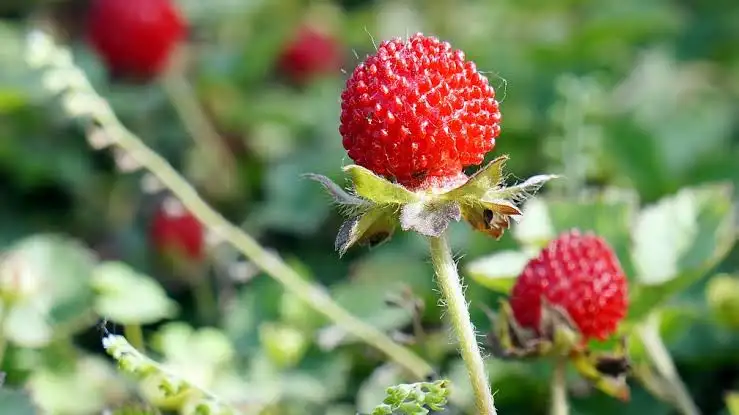
Mock strawberries also known as Indian strawberry, mock strawberry is a ground-hugging perennial plant. Spreads by runners to form low-lying colonies in moist woodlands and lawns. May be confused with the native wild strawberry, which is also low-growing but has white petals and flavored fruit. Fruits of mock strawberries are small, red, strawberry-like berries and are virtually flavorless. Unlike native wild strawberry, mock strawberry fruit points up, away from the ground, making the fruit highly visible.
Red Chokeberry
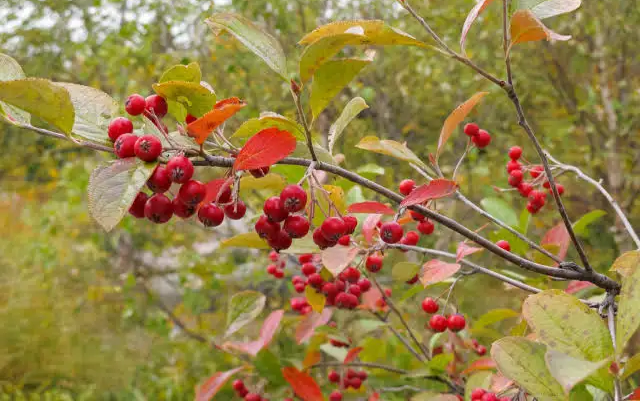
The Red Chokeberry is a shrub that grows to around 8 feet tall and 3 feet across. It has white flowers in spring, red berries from late summer to mid-winter, and the rich-green, glossy leaves turn gorgeous shades of scarlet, crimson, purple and orange in the fall. This plant is a great choice for natural plantings, and it also fits well into more structured gardens, growing alongside other shrubs and flowers, and adding interest and color in many seasons. The berries cannot be eaten raw, but they do make delicious preserves and jams.
Barberry
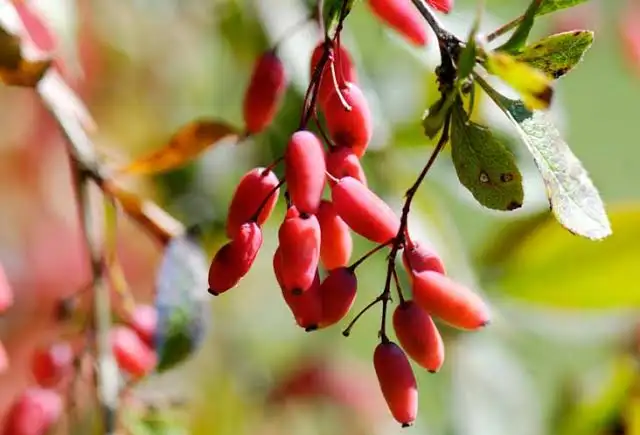
Barberries are long red berries that grow on barberry shrubs, which have branches covered in yellow flowers. Barberry bushes are hardy deciduous plants commonly used in gardens or as foundation bushes due to their low maintenance requirements and adaptability. Barberries are also frequently used as a hedge because of their uniform growth pattern. Although barberries can grow to heights of 10 feet or more, about the size of small trees, most are smaller and grow on multiple stems.
Red currants
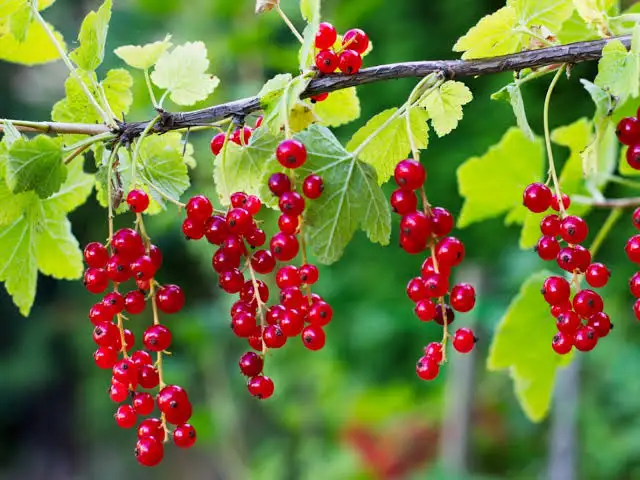
Red currants produce clusters of berries in shades of pale red to bright crimson or deep red, depending on the variety. Redcurrants bushes are usually grown as goblet-shaped bushes and normally have a height and spread of 1.5m (5′) and so are only suitable for big gardens or allotments. In spring, red currant flowers show a yellowish tint. With their upright growth habit and attractive, maple-like leaves, red currants are a wonderful addition anywhere in your landscape.
Red Huckleberries
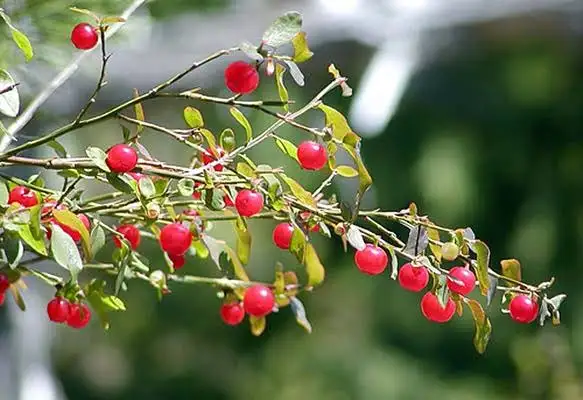
Huckleberries grow on shrubs that can be up to 10 feet tall and 5 feet wide. Leaves are thin and elliptical in shape. They are placed alternately along the leaf stem. Leaves are glossy green on top and lighter in color underneath. Leaves are green on the upper surfaces and paler beneath. When flowers form, they resemble those of cultivated blueberries. The pale and waxy cup-shaped flowers turn into red, round berries that are slightly over a quarter-inch in diameter. Red huckleberries are bright red when ripe. In winter, red huckleberry shrubs shed their leaves, making identification difficult.
Hinnomaki Red gooseberry

Hinnomaki Red gooseberry is a variety from Finland with superb flavor, high yields, and a beautiful red fruit color. The outer skin is tangy while the flesh is sweet. The plants grow upright and are mildew resistant. These very productive plants are adaptable to various growing systems, hedge or ornamental. The sweet berries can be eaten fresh or baked in a pie.
Pin Cherry
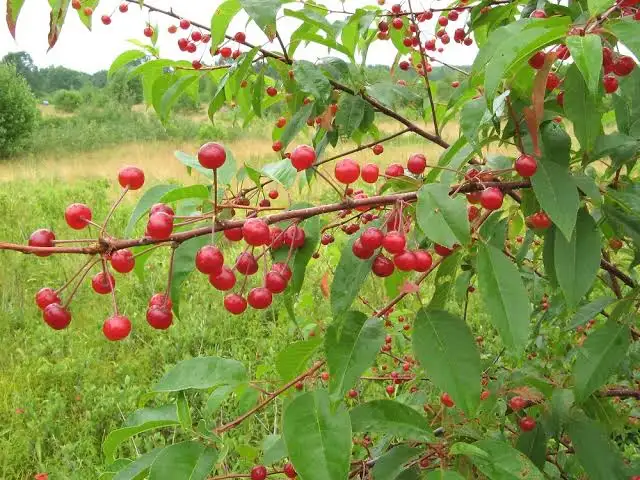
Pin cherry trees produce tight clusters of small, white flowers. In the late summer, dark, fruit drupe will grow that is very deep red and rather small. The pin cherry tree is a short little tree, with a straight and narrow trunk that grows up into a rounded crown. The branches of a pin cherry tree grow horizontally and are quite delicate. The pin cherry tree is also known as bird cherry, wild red cherry, and fire cherry. It was granted the nickname “fire cherry” since small shrubs explode in areas that have experienced a forest fire.
Cotoneaster

Cotoneaster shrubs have a unique, dimorphic growth pattern, which means they produce long branches that provide structure to the plant and short shoots that bear the flowers and berries. Smooth-edged leaves are arranged alternately, and can be long and ovate or small and round, and there are both deciduous and evergreen species. The fruit is a small pome, pink or bright red, orange or even maroon or black when mature, containing one to three (rarely up to five) seeds. Fruit on some species stays on until the following year.
Hobblebush

Hobblebush inhabits the understory of cool forests. It grows three to six feet tall, to a maximum of ten feet with pendulous branches that take root where they touch the ground. These rooted branches form obstacles which easily trip (or hobble) walkers – hence the common name. Hobblebush leaves are opposite, meaning that there are two leaves per node. Hobblebush flowers usually appear by mid-May, depending on the weather. The fragrant white flowers are flat-topped clusters 2-6 inches wide. The red berries of the Hobblebush reportedly may be eaten raw or cooked and is said to taste somewhat like raisins or dates.
Buckthorns
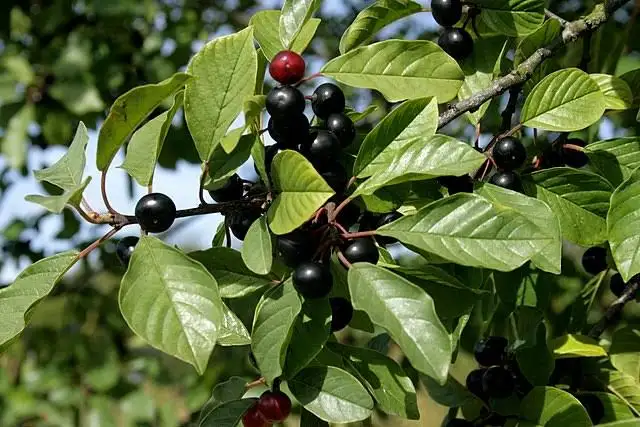
Buckthorns are native to both temperate and tropical regions. It grows 10 to 15 feet tall and bears shiny green leaves and showy red fruits that are attractive to birds and other wildlife. It does not bear thorns. Although some types of buckthorn are prized ornamentals in the yard, others grow rapidly into a dense stand that steals nutrients from or shades out native plants, and can be difficult to eliminate.
Tatarian honeysuckle bush
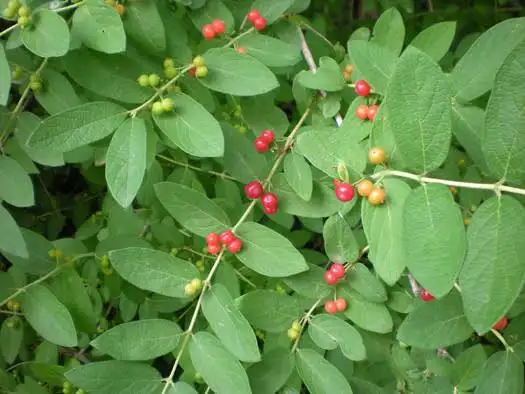
Tatarian honeysuckle bush also known as pink honeysuckle is a species of honeysuckle shrub often cultivated in home landscapes as ornamental vines and are prized for their rapid growth and fragrant, attractive blooms. The inflorescence ranges in color from deep rose to light pink, and can also be white. The berries are attractive to wildlife. The plant forms thickets and spreads easily when birds and other animals consume the fruits. Tatarian Honeysuckle can become invasive, invading open woodlands, thickets, fence rows, and roadsides.
Winterberry

A slow-growing shrub with a rounded upright growth habit, winterberry typically grows 3 to 15 feet tall and readily suckers and spreads to form large thickets. It is generally planted in late summer to early fall, though spring planting is usually successful, as well. Winterberry holly is often associated with the Christmas holiday season and their berry-laden stems are used to add color to evergreen arrangements. Winterberry branches appear twiggy and dark gray; they are most noticeable in winter when they are leafless and supporting the berries.
Cornelian-cherry dogwood

Cornelian-cherry dogwood, one of the first trees to flower in spring, is a small, 20 to 25 feet high tree or large shrub. It thrives in well-drained urban conditions as a specimen plant, in masses, near a patio, or as a hedge. Tight clusters of small star-shaped yellow flowers bloom in early spring, covering the tree before leaves emerge. The clusters of yellow flowers are similar in appearance to forsythia, and the red stone fruits (drupes) that ripen in July resemble olives in size and shape. They are used in European cuisine for drinks, syrups, preserves, jams, and sauces.
Peruvian Pepper or Peppercorn Tree

Peruvian Pepper is a quick growing evergreen tree that grows up to 15 meters (50 feet) tall and wide. It is a quick growing evergreen tree and its branches tend to droop. This drooping canopy covers extensive areas, having a rounded or umbrella shape. The Peruvian pepper tree’s leaves contain a volatile oil in leaf storage cells, which emit a peppery fragrance when they are broken. Its flowers are small, white and borne profusely in panicles at the ends of the drooping branches.These flowers can be divided into female and male, the female one will produce “peppers” or small pink berries.
American holly tree

The American holly tree, an ornamental evergreen, is often used as a focal point in the yard and for holiday decorations.The American holly grows to a height of 40–50 feet and a spread of 3 to 5 feet at maturity. This tree grows at a slow to medium rate, with height increases of anywhere from less than 12 to 24 inches per year.The bark is light gray, roughened by small warty lumps. The branchlets are stout, green at first and covered with rusty down, later smooth and brown. The winter buds are brown, short, obtuse or acute. The fruit is a small red berry or drupe containing four seeds; it is often persistent into winter.
Hawthorn

Mature trees can reach a height of 15m and are characterised by their dense, thorny habit, though they can grow as a small tree with a single stem. The bark is brown-grey, knotted and fissured, and twigs are slender and brown and covered in thorns. The white or pink flowers, usually in clusters, are followed by small applelike pomes that range from red to orange to blue or black. The fruits vary in flavour and texture but are edible and sometimes used in herbal medicine.
Buffalo Berry

Buffalo berry is a shrub that reaches some 2 to 6 metres (about 6 to 20 feet) in height. The whitish branches are somewhat thorny and bear small oblong silvery leaves. The fruit, borne in profusion in August or September, is a currant-sized scarlet-red or golden-yellow berry with a tart flavour. Because it is tolerant of windswept sites on dry rocky soil, it is valued as an ornamental and hedge plant where other shrubs often fail. The berries are used to make a meat relish and jelly.
Butcher’s broom

Butcher’s broom is a bushy evergreen subshrub that grows to 3 feet in height, with flat shoots known as cladodes that give the appearance of stiff, spine-tipped leaves. Small greenish flowers appear in spring, and are borne singly in the centre of the cladodes. The female flowers are followed by a red berry, and the seeds are bird-distributed, but the plant also spreads vegetatively by means of rhizomes. The stems make lovely and durable greenery for cut flower arrangements, and they are available year round. When you cut stems in late fall or early winter, you can store them in the refrigerator for up to five months.
Raspberries

Raspberries are fast-growing, deciduous shrubs characterized by short-lived, thorny canes and antioxidant-rich berries, which are usually produced in droves in summer and autumn. They can grow in any direction, quickly becoming a dense patch of brambles if they are not controlled. Raspberries grow best in an open, exposed and sunny location with plenty of air circulation to help prevent diseases.
Red Elderberry
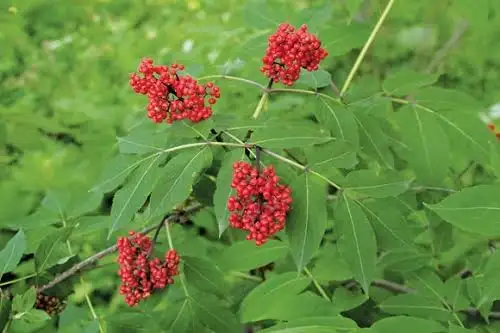
Elderberry is a shrubs that typically grow 5 to 12 feet tall, but some can soar to heights of 20 feet. These taller elderberry bushes often appear more like multistemmed trees in the garden. Elderberry bushes have deciduous leaves that grow 5 to 9 inches long. Though their pale flowers are tiny, they grow in sizable clusters that can span up to a foot. These showy clusters make elderberry bushes especially recognizable in summer, when the flowers blossom. The dark, berrylike fruit also grows in clusters in summer and early fall; each fruit is approximately 1/4-inch in diameter.
Common Spindle

Common spindle also referred to as European spindle is a deciduous plant that can be grown as either a large shrub or small tree, reaching up to 30 feet tall. Spindle fruits are perhaps the most unusual of all our native trees and shrubs. They consist of green ‘capsules’ that become become bright red when they are ripe. Oil produced from this plant is used for soap making. The seed coating is used to create a yellow dye, and charcoal obtained from the wood is prized by artists.
Strawberries

Strawberries are not technically berries or fruit, but rather the ends of the plant’s stamen. The fruits of strawberry plants are actually the small black spots on the “berry.” A strawberry flower averages five to seven petals, while a typical strawberry has 150 to 200 seeds on its surface. The seeds can grow to make new plants, but most strawberry plants instead reproduce by runners. Under certain conditions, strawberry plants have been known to form matted colonies that live up to 50 years.
Nanking Cherries

The Nanking Cherry is a beautiful rounded ornamental shrub that provides year round color. In early spring, pink buds open up into fragrant white or pale pink flowers. Nanking cherries grow on a medium-sized shrub that reaches no more than 2 and a half meters tall. The small red fruits, or drupes, grow in clusters on short stems. The clusters of fruit are nestled in among the leaves, spaced out at intervals along the branches.
American bittersweet
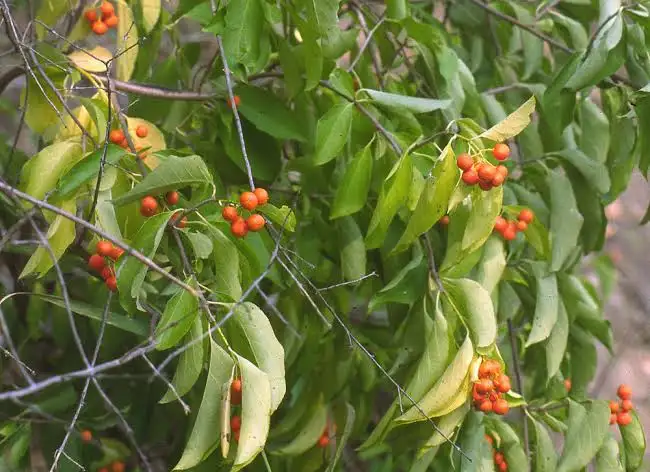
American bittersweet is a vigorous deciduous, perennial vine that grows 15 to 20 feet tall and grows quickly, covering trellises, arbors, fences, and walls.It is best known for its bright red berries and yellow leaves in the fall. When growing bittersweet for the attractive berries, you’ll need both a male and female plant. The female plants produce the berries, but only if there is a male plant nearby to fertilize the flowers.
Highbush cranberry

The highbush cranberry is actually not a cranberry at all, though its fruit, or ‘drupes’ as they are known taxonomically, strongly resemble cranberries in both appearance and taste. They also mature in the fall, as cranberries do. Highbush cranberry plants are showy in spring when the flowers bloom against a backdrop of lush, dark green foliage. Like lacecap hydrangeas, the flower clusters have a center made up of small fertile flowers, surrounded by a ring of large, sterile flowers. These plants take center stage again in fall when they are loaded with bright red or orange berries that hang from stems like cherries.
Linden viburnum

The linden viburnum gets it’s common name because its leaves resemble those of the linden tree. The shrub grows 8-10 feet tall and 6-8 feet wide.The bark of the stems are brown with some orange, the stems are pubescent, and stems change color from brown to a dark gray as they mature. The clusters of white flowers in spring are followed by red glabrous fleshy round drupe that grows in clusters like its flowers which matures to black in fall and winter.
Evans Cherry

The Evans cherry also referred to as Bali cherry has showy white flowers in spring followed by loads of bright red cherries in mid-summer. Evans cherry is bathed in stunning clusters of fragrant white flowers along the branches in mid-spring before the leaves. It has dark green foliage throughout the season. The pointy leaves turn an outstanding orange in the fall. The drooping cherry fruits can be messy if allowed to drop on the lawn or walkways. This is a self-pollinating variety, so it doesn’t require a second plant nearby to set fruit. The smooth dark red bark adds an interesting dimension to the landscape.